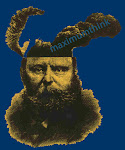Not only did Bush fail to take over the New Orleans offense, he failed to do much to impress. He went the entire first half of his rookie season without scoring a touchdown and totaling a dismal 2.55 ypc, all while being completely healthy. He was a surefire game-breaker, yet his career-long rush is just 22 yards. This isn’t because the pro-level Bush lost his talent, though. Rather, the pro-level Bush is trying to fit his spherical game inside a square box of an offense.
In no way do I mean to insinuate that the Saints offense is boring, rather linear, or vertical. Brees stretches the field lengthwise with his arm, creating pockets and mismatches. He has pinpoint accuracy at any spot on the field; and as soon as Sean Payton got him under center, his entire offense was fixated around him.

And while Brees makes studs out of Marques Colston, Devery Henderson and Terrence Copper, Bush somehow gets lost in the mix. The Saints have so many offensive weapons that Brees makes better within their vertical game, there’s no reason for them to adapt their entire offense to fit Bush’s more horizontal scope. Whereas the Saints create mismatches and run smart routes, Bush is most effective when he gets out in space and improvises with his legs.
Bush does not fit in a pro-style offense because he is not a pro-style running back. He did play in a relatively pro-style set at USC, but that offense hinged on Bush’s game-breaking ability. He was able to get by without an entire offense committed to his style because he was that much more athletic than the rest of the Pac 10.
Bush was dominant at USC where he forced all his own breaks, but just imagine how he would have played in a system more suited for his skill set, like West Virginia. If an entire offense was devoted to taking advantage of speed and agility, Bush would have had to work even less to embarrass opposing defenses. Or, as dominant as Jonathan Stewart was with Dennis Dixon at Oregon last season, imagine the possibilities if that had been Bush in the backfield instead. If he was given the opportunity to run completely wild, filling any and every slot on the field, his game would have been boundless.
This athletic abundance is reminiscent of another emerging star, Darren McFadden. At Arkansas McFadden was given total freedom on the field, and though the rest of his offense struggled to keep pace, he still excelled in every facet imaginable. Allowed an open role, a transcendent talent can transcend the game.

Bush and Brees are a conflicted backfield, and the rest of the offense dictates that Brees wins creative control. Chances are, Bush’s stats would not be so modest if his backfield partner was more attuned to his athleticism. Vince Young or even David Garrard seem the obvious candidates now, but the true blissful marriage would have been Bush and Vick. The ultimate combination of athleticism in Hotlanta would have turned defenders upside-down, but now that’s an impossibility.

In the end, it’s probably unfair to criticize Bush about his ypc: Bush is of a whole different mindset than the rest of the league. Each time he gets the ball he’s not looking for four yards, he’s looking for six points. He’ll sacrifice a certain three or four yard gain for the possibility of picking up 30 every single time. For him, that’s the biggest adjustment to the NFL. Physically he’s never had to sweat, but mentally he needs to shift his entire paradigm to a more pro model, or at least so long as he’s playing on the Saints.
All of this comes back to the common thread: Bush’s talent is diluted at running back because he is not a running back in the truest sense of the position, and that’s the sense of the position the Saints require. Bush is football’s equivalent of the combo guard. He’s a running back and a receiver, but he’s more athlete than either of those necessitates. His talent transcends his role on the field, yet he has not found an outlet through which to channel his athleticism at the professional level.
The type of commitment required to fully enable a back like Bush in the NFL is far too risky. West Virginia can get away with it because the speed of college teams is often suspect, but the NFL plays with incomparable speed and depth. For a team to commit to one player and such a narrow-minded strategy so wholeheartedly would run the risk of forfeiting four or five seasons because the effects would be that detrimental. But as long as Bush is sharing the backfield with Drew Brees, a return to his glory days as the league’s most exciting back will never come to fruition.










